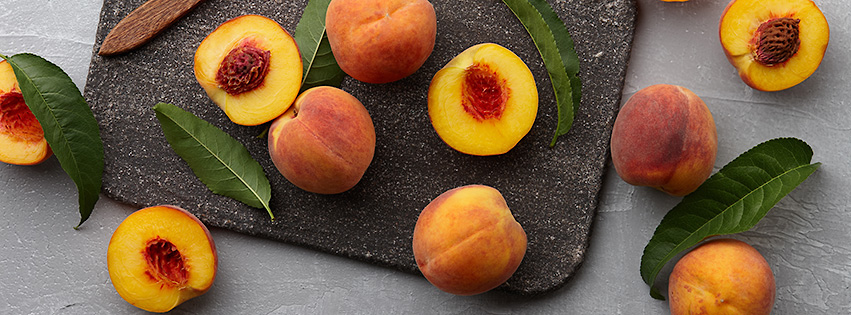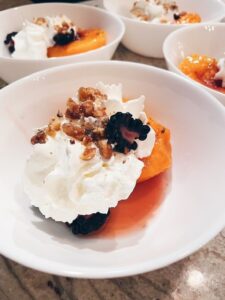Life’s a Peach: A Chef’s Juicy Memory of Discovering America (with recipes!)
- by bonappetit

By Executive Chef Mayet Cristobal
Chef Mayet is being honored during 2021’s Chef Appreciation Week.
The first time I ate a peach was during our first family road trip in the United States. It was about eight months after we arrived in the U.S. from the Philippines, and we were going to meet our step-grandparents for the first time. The trip was a 350-mile drive from South Carolina to Alabama. My stepdad drove while my mom held the map in the front passenger seat trying to navigate our way along I-85.
As we drove through Georgia, we stopped at a gas station, which happened to be located next to a peach stand. While filling up the car, my stepdad insisted that it was only fitting we buy some peaches, since we were in the Peach State. Growing up in the Philippines, I didn’t even know what peaches were. I grew up in a world of mangoes, papayas, guava, and a long list of other tropical fruits that grow in Southeast Asia. Since my stepfather insisted that I try one (and because there was nothing else to do), I allowed myself to try a peach.
Boy, was I glad I did!
At that moment, my eternal love for the stone fruit was born. My first bite was perfect. It had the unexpected crisp texture once my teeth sank into it, then the soft and juicy flesh followed. It was sweet and a little tart at the same time. I knew then that I would forever miss my birth country, but I also knew that my new home would bring with it many new things. If my first taste of the U.S. was this good, then the possibilities were endless!
Since then, during summertime, I do my best to eat as many peaches as I possibly can. I like them in pies and cobblers, salads, salsas, or sauces. I love them simply as-is, eaten on their own, or with fresh cheese like burrata or ripe brie.
This August, my husband and I decided to host a small gathering for friends and cooked up a menu of seasonal favorites. The best was a dessert made of peaches poached in prosecco and honey. Lightly sugared on top, torched to produce a caramelized top, then served with whipped cream, crushed candied walnuts, blueberries, and reduced poaching liquid. It was a simple dessert but it was also grand in its own way. The entire evening was magic. The joy of seeing old friends, meeting new ones, and breaking bread together was inexpressibly wonderful after so much time apart. It took sharing peaches with friends at our dinner party to remind me how much I appreciated my first road trip, my first peach, and the hundreds thereafter.
To celebrate these last days of summer, I would like to share a recipe for the peach dessert we enjoyed during our gathering. I hope you get to enjoy it on a sunny day, with someone you think is a peach.
Prosecco-Poached Peaches with Honey
Serves 5
1 bottle of prosecco, 750 ml
4 oz. of honey
1 cup orange juice
5 cloves
1 cinnamon stick
½ of vanilla bean, scraped
5 peaches, washed, cut in half, pit removed (peaches must be firm but ripe)
whipped cream
blackberries (optional garnish)
candied walnuts (optional garnish)
Combine prosecco, honey, orange juice, cloves, cinnamon stick, and vanilla bean in a pot over medium heat. Bring the liquid to a boil then bring down to a simmer.

Gently add the peaches, cover with a lid. Simmer the peaches in the liquid for about 12 minutes, until the peaches are tender but not falling apart. Turn off heat. Let the peaches cool in the liquid. Remove the peaches from the liquid using a slotted spoon and gently peel off skin.
Reduce the poaching liquid over low heat until it has a syrup consistency. This could take 45 minutes. The poaching liquid is good served warm or room temperature.
To serve:
Place one or two halves of the peach in a bowl. Drizzle a tablespoon of the reduced poaching liquid. Top the peaches with whipped cream. Garnish the peach with blackberries and chopped candied walnuts if desired.
If you’re feeling inspired, sprinkle raw sugar on the cut side of the peach half, then immediately torch the sugar using a kitchen butane blow torch until the sugar gets slightly burnt.